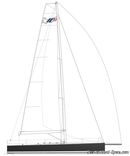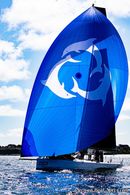Melges IC37
Sailboat specifications
The Melges IC37 is a 37’1” (11.3m) racing sailboat designed by Mills Design (Ireland). She is built since 2019 by Melges (United States). She has been awarded "2019 - Sailing World - Boat of the Year: Corinthian".
Melges IC37's main features
- Model
- Melges IC37
- Hull type
- Monohull
- Category
- Racing sailboat
- Sailboat builder
- Sailboat designer
- Country
- United States
- Construction
- Fiberglass reinforced epoxy:
Sandwich foam E-glass epoxy with carbon fiber reinforcements - First built hull
- 2019
- Last built hull
- Still in production
- Award(s)
- 2019: Sailing World - Boat of the Year: Corinthian
- Appendages
- Keel : T-shaped keel (with bulb)
- Helm
- Single tiller (helm wheel in option)
- Rudder
- Single spade rudder
- Unsinkable
- No
- Trailerable
- No
- EC design categoryiThe CE design category indicates the ability to cope with certain weather conditions (the sailboat is designed for these conditions)
A: Wind < force 9, Waves < 10m
B: Wind < force 8, Waves < 8m
C: Wind < force 6, Waves < 4m
D: Wind < force 4, Waves < 0,5m - A
- Standard public price ex. VAT (indicative only)
- N/A €
Melges IC37's main dimensions
- Hull length
- 37’ 1”11.3 m
- Waterline length
- 34’ 10”10.6 m
- Beam (width)
- 12’3.65 m
- Draft
- 8’ 2”2.5 m
- Light displacement (MLC)
- 7793 lb3535 kg
- Ballast weight
- 3373 lb1530 kg
- Ballast type
- Carbon fiber fin with lead bulb
Melges IC37's rig and sails
- Upwind sail area
- 899 ft²83.5 m²
- Downwind sail area
- 2180 ft²202.5 m²
- Mainsail area
- 522 ft²48.5 m²
- Jib area
- 377 ft²35 m²
- Asymmetric spinnaker area
- 1658 ft²154 m²
- IiFore triangle height (from mast foot to fore stay top attachment)
- 50’ 8”15.45 m
- JiFore triangle base (from mast foot to bottom of forestay)
- 14’ 5”4.39 m
- PiMainsail hoist measurement (from tack to head)
- 48’ 6”14.79 m
- EiMainsail foot measurement (from tack to clew)
- 16’ 5”5 m
- Rigging type
- Sloop Marconi (square top mainsail) 9/10
- Mast configuration
- Keel stepped mast
- Rotating spars
- No
- Number of levels of spreaders
- 2
- Spreaders angle
- Swept-back
- Running backstays
- 1 set(s)
- Spars construction
- Carbon fiber spars
- Standing rigging
- Single-strand (ROD) discontinuous
Melges IC37's performances
- Upwind sail area to displacementiThe ratio sail area to displacement is obtained by dividing the sail area by the boat's displaced volume to the power two-thirds.
The ratio sail area to displacement can be used to compare the relative sail plan of different sailboats no matter what their size.
Upwind: under 18 the ratio indicates a cruise oriented sailboat with limited performances especially in light wind, while over 25 it indicates a fast sailboat. - 387 ft²/T35.98 m²/T
- Downwind sail area to displacementiThe ratio sail area to displacement is obtained by dividing the sail area by the boat's displaced volume to the power two-thirds.
The ratio sail area to displacement can be used to compare the relative sail plan of different sailboats no matter what their size. - 939 ft²/T87.26 m²/T
- Displacement-length ratio (DLR)iThe Displacement Length Ratio (DLR) is a figure that points out the boat's weight compared to its waterline length. The DLR is obtained by dividing the boat's displacement in tons by the cube of one one-hundredth of the waterline length (in feet).
The DLR can be used to compare the relative mass of different sailboats no matter what their length:
a DLR less than 180 is indicative of a really light sailboat (race boat made for planning), while a DLR greater than 300 is indicative of a heavy cruising sailboat. - 84
- Ballast ratioiThe Ballast ratio is an indicator of stability; it is obtained by dividing the boat's displacement by the mass of the ballast. Since the stability depends also of the hull shapes and the position of the center of gravity, only the boats with similar ballast arrangements and hull shapes should be compared.
The higher the ballast ratio is, the greater is the stability. - 43 %
- Critical hull speediAs a ship moves in the water, it creates standing waves that oppose its movement. This effect increases dramatically the resistance when the boat reaches a speed-length ratio (speed-length ratio is the ratio between the speed in knots and the square root of the waterline length in feet) of about 1.2 (corresponding to a Froude Number of 0.35) . This very sharp rise in resistance, between speed-length ratio of 1.2 to 1.5, is insurmountable for heavy sailboats and so becomes an apparent barrier. This leads to the concept of "hull speed".
The hull speed is obtained by multiplying the square root of the waterline length (in feet) by 1.34. - 7.90 knots
Melges IC37's auxiliary engine
- Engine(s)
- 1 inboard engine
- Engine(s) power
- 21 HP
- Fuel type
- Diesel
- Fuel tank capacity
- 15.1 gal57 liters
Melges IC37's accommodations and layout
- Cockpit
- Open aft cockpit
Similar sailboats that may interest you:
Sailboats
First built hull
Hull length
2010
33’ 11”10.34 m
2003
33’ 2”10.11 m
2007
40’12.18 m
2014
40’12.19 m
2017
32’9.75 m
2014
40’12.18 m
2009
40’12.18 m
2017
40’12.2 m
2013
28’ 7”8.72 m
2010
38’ 8”11.8 m
2014
32’ 10”9.99 m
2019
36’ 1”11 m
1999
31’ 4”9.54 m
2008
32’ 8”9.98 m
2018
35’ 5”10.8 m












